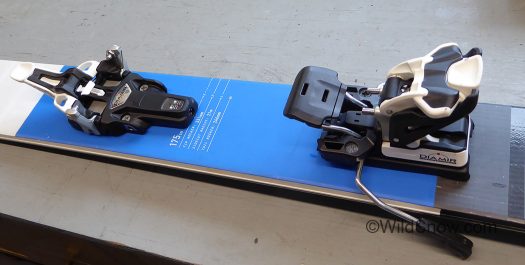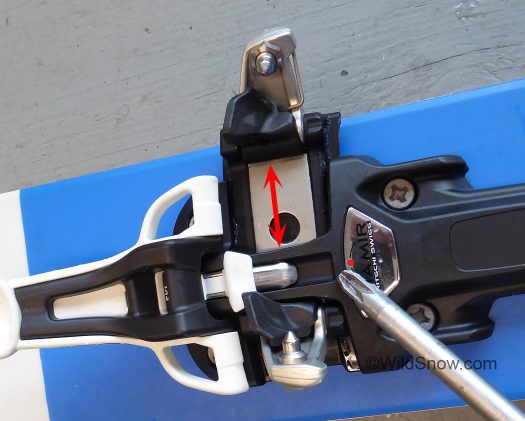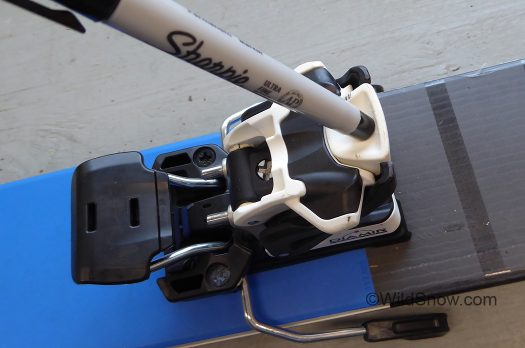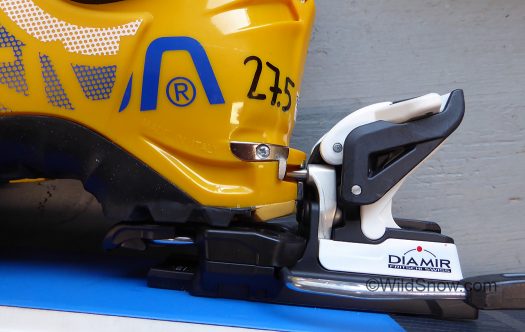Note: What is this binding actually named? You’ll see it called “Diamir Vipec 12 TUV” or just “Diamir Vipec 12” or “Black Diamond Fritschi Diamir Vipec 12 TUV Binding w/ Brake.” In our case we call it Diamir Vipec 12 Black, or a condensate thereof. A previous “12” model exists as well. If shopping take care what you order. We don’t recommend the previous model; this “Black” version is way too much of an improvement.

Fritschi Diamir Vipec 12 Black. On snow testing results in skiing with two thumbs up. Looks odd, but I couldn’t help it.
Ok, I’ve been on these guys for multiple days. Even used Vipec 12 Black for lift skiing so I’d have to step-in fast enough to keep up with folks on their alpine clamps. Clearly, this model is a significant upgrade of the Diamir Vipec.
Most importantly for me, the binding is much easier to click onto your boot toe during entry. However, I did still find Vipec 12 a bit more difficult to enter than many other tech bindings, depending on how much snow or ice was shimmed between my boot toe and the trigger zone. I also occasionally had trouble exiting, due to ice or dense snow preventing my pushing the opening lever down to its full range.
Despite my life altering Vipec trials (oh, those 3 extra seconds to click in were so painful!), I’m certain that with a modicum of learning about positioning your foot and clearing snow the entry-exit process is now acceptable. This may not be so with other Vipec models (depending on your boot brand and willingness to learn, or at least willingness to fiddle).
We covered many details (including anti-icing improvements) of the 12 Black in previous posts, this summary review is intended to hit items I found personally significant. (Note that “White” model Vipec 12 sold for winter 2015-2016 also had improvements for the toe entry, but lacked the overall excellent changes of the “Black.”

Significant improvement for me was the more conventional tech binding closure trigger. Nonetheless, I found this to be more sensitive to boot position and snow/ice buildup than other bindings I use, which to be fair are fiddly as well, just not quite so much. Note the black “boot toe locators.” Those help if your boot is the correct shape and you don’t have any snow or ice getting in the way. I found they can obstruct positioning of the boot as well (same as other brands with similar feature).

Exceptional lateral travel in the toe is impressive. This was improved by reducing material in the visible plastic center section the “carriage” rides underneath, thus allowing one side of the carriage to move farther in while the other moved farther out. I didn’t do any scientific measurement of travel distance but I’m certain this equals and perhaps exceeds most alpine bindings. Quite impressive.

As with all other Vipec, if you’re in downhill mode just push on this lever with your ski pole and snap, you’re in touring mode (after a stomp to stow the brake). While this is not so much marriage enhancement option for myself and Vipec, I do enjoy on occasion and I know many of you readers do as well. Thus worth mentioning this feature has not changed. Getting back into alpine mode involves reaching down and pulling the white lever up — slightly awkward but doable.

Most tech bindings incur safety release by rotating left-right at the heel. Problem with that is sometimes you need those same forces to turn a ski, and you’ll thus experience a bit of “softness” in feel. All Vipec bindings, on the other hand, have no rotation in the heel. If you’re used to classic tech bindings you can feel the difference. Does it ski any better? In my case I don’t think so, but larger or more aggressive skiers than I may beg to differ. Perhaps most importantly for everyone, with this machinery its impossible to pre-release to the side at the heel. But wait, there is more. Vipec looks so slick and modern, it’s hard to accept it has the same limited vertical elasticity as any other classic tech binding. If you like actually setting your bindings to “chart” release settings that can be a problem — especially with big high-leverage boots in rough terrain. The Fritschi guys are smart, they know this is an achilles heel of an otherwise amazingly improved tech binding. At ISPO last winter I asked about improving vertical heel travel. I got a knowing Swiss half-smile. Keep your eyes open for something innovative that builds on the Vipec 12 platform, only with a heel that rises higher to the occasion, literally.
I’d be remiss in not mentioning that yes, this version of Vipec received TUV certification for DIN/ISO ski touring binding standard 13992. What’s that mean? We think how a binding performs in general “consumer” testing is more important. If the honest opinions of professional skiers reviewers support that take, then TUV is just one pixel on the HD screen of real life. (In the case of 12 Black, the consensus is definitly good. Only glitch I’ve heard is a few bindings that “slip” at the heel when locked in downhill mode. Solution: warranty or perhaps user error correction.) We have lots of content about TUV certifications.
Conclusion: Vipec 12 Black is a viable and potent solution for those wanting a “tech” binding that releases to the side at the toe with impressive elasticity. It has a learning curve. While the toe has impressive lateral travel and elasticity, the heel unit has no more vertical travel than any other conventional tech binding (meaning it has very little). In terms of ski “feel” the non-rotating heel does yield a solid impression. How much of that is merely psychological, and how much it actually helps you ski better, is personal. Me, I don’t need the additional heel stability but I can indeed feel it. Overall Wildsnow thumbs up but we suggest you try before you buy (as with many other brands and models).
Check out this Vipec comparison we did last winter, for details.
Some of you have asked about perhaps combining a Vipec toe with a heel from another brand-model that allows side release or perhaps more vertical elasticity. We tried that here.
Shop for Fritschi Diamir Vipec
WildSnow.com publisher emeritus and founder Lou (Louis Dawson) has a 50+ years career in climbing, backcountry skiing and ski mountaineering. He was the first person in history to ski down all 54 Colorado 14,000-foot peaks, has authored numerous books about about backcountry skiing, and has skied from the summit of Denali in Alaska, North America’s highest mountain.
